Critical Analysis: CVAD Infections and Occlusion Prevention Report
VerifiedAdded on 2020/10/22
|7
|1554
|271
Report
AI Summary
This report analyzes the complications associated with central venous access devices (CVADs), focusing on the case of Joseph Russo. The report delves into the prevention of CVAD-associated bloodstream infections, detailing measures such as hand hygiene, maximal barrier precautions, chlorhexidine skin antisepsis, optimal catheter site selection, and catheter maintenance. It also addresses the prevention and management of catheter occlusion, discussing strategies to avoid delays in therapy, reduce patient discomfort, and minimize the risk of thrombosis. The report concludes by emphasizing the importance of nursing care in managing these complications and ensuring patient well-being, referencing relevant literature to support the discussed practices and strategies. The report provides a comprehensive overview of the nursing interventions and medical procedures required to mitigate the risks associated with CVADs, offering valuable insights for healthcare professionals and students alike.
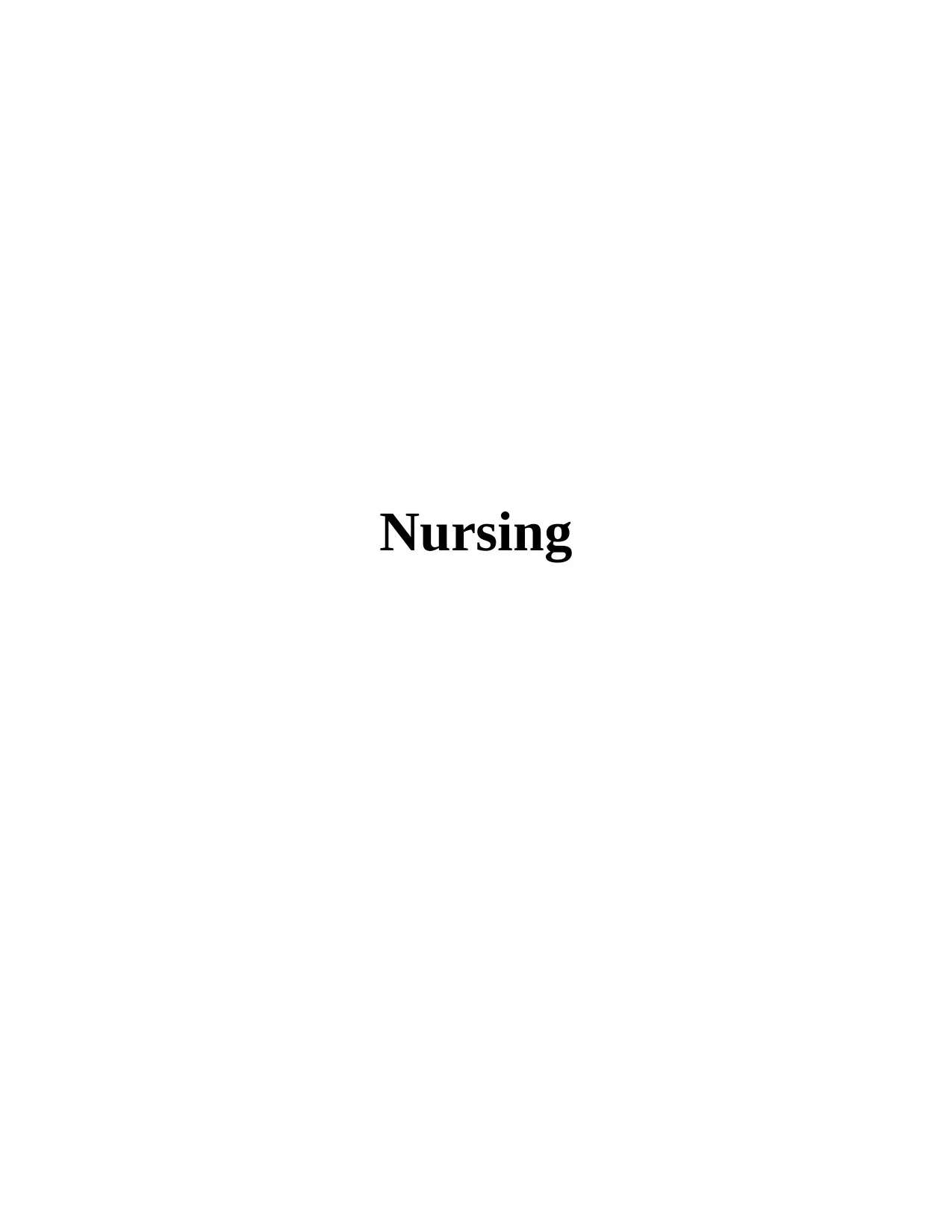
Nursing
Paraphrase This Document
Need a fresh take? Get an instant paraphrase of this document with our AI Paraphraser
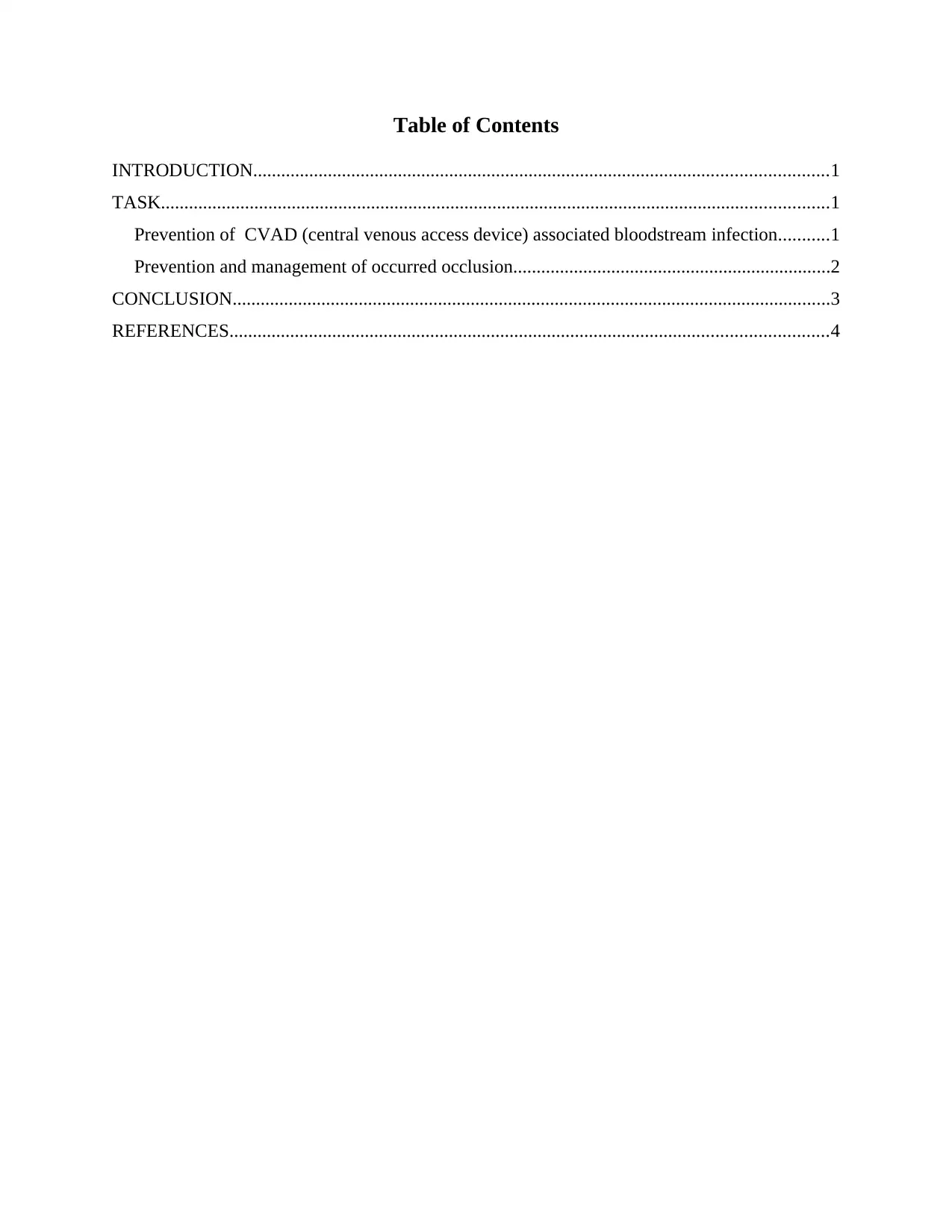
Table of Contents
INTRODUCTION...........................................................................................................................1
TASK...............................................................................................................................................1
Prevention of CVAD (central venous access device) associated bloodstream infection...........1
Prevention and management of occurred occlusion....................................................................2
CONCLUSION................................................................................................................................3
REFERENCES................................................................................................................................4
INTRODUCTION...........................................................................................................................1
TASK...............................................................................................................................................1
Prevention of CVAD (central venous access device) associated bloodstream infection...........1
Prevention and management of occurred occlusion....................................................................2
CONCLUSION................................................................................................................................3
REFERENCES................................................................................................................................4

⊘ This is a preview!⊘
Do you want full access?
Subscribe today to unlock all pages.

Trusted by 1+ million students worldwide
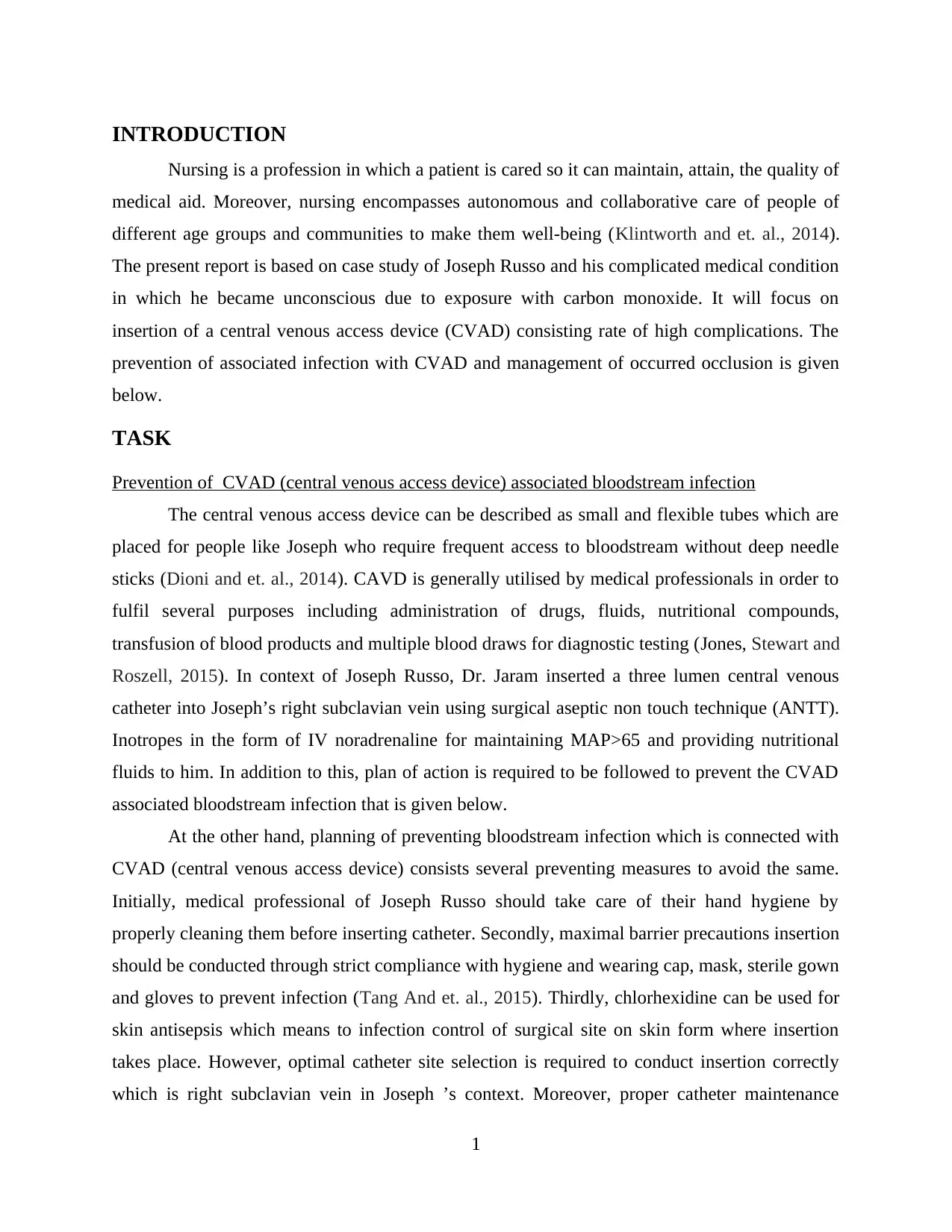
INTRODUCTION
Nursing is a profession in which a patient is cared so it can maintain, attain, the quality of
medical aid. Moreover, nursing encompasses autonomous and collaborative care of people of
different age groups and communities to make them well-being (Klintworth and et. al., 2014).
The present report is based on case study of Joseph Russo and his complicated medical condition
in which he became unconscious due to exposure with carbon monoxide. It will focus on
insertion of a central venous access device (CVAD) consisting rate of high complications. The
prevention of associated infection with CVAD and management of occurred occlusion is given
below.
TASK
Prevention of CVAD (central venous access device) associated bloodstream infection
The central venous access device can be described as small and flexible tubes which are
placed for people like Joseph who require frequent access to bloodstream without deep needle
sticks (Dioni and et. al., 2014). CAVD is generally utilised by medical professionals in order to
fulfil several purposes including administration of drugs, fluids, nutritional compounds,
transfusion of blood products and multiple blood draws for diagnostic testing (Jones, Stewart and
Roszell, 2015). In context of Joseph Russo, Dr. Jaram inserted a three lumen central venous
catheter into Joseph’s right subclavian vein using surgical aseptic non touch technique (ANTT).
Inotropes in the form of IV noradrenaline for maintaining MAP>65 and providing nutritional
fluids to him. In addition to this, plan of action is required to be followed to prevent the CVAD
associated bloodstream infection that is given below.
At the other hand, planning of preventing bloodstream infection which is connected with
CVAD (central venous access device) consists several preventing measures to avoid the same.
Initially, medical professional of Joseph Russo should take care of their hand hygiene by
properly cleaning them before inserting catheter. Secondly, maximal barrier precautions insertion
should be conducted through strict compliance with hygiene and wearing cap, mask, sterile gown
and gloves to prevent infection (Tang And et. al., 2015). Thirdly, chlorhexidine can be used for
skin antisepsis which means to infection control of surgical site on skin form where insertion
takes place. However, optimal catheter site selection is required to conduct insertion correctly
which is right subclavian vein in Joseph ’s context. Moreover, proper catheter maintenance
1
Nursing is a profession in which a patient is cared so it can maintain, attain, the quality of
medical aid. Moreover, nursing encompasses autonomous and collaborative care of people of
different age groups and communities to make them well-being (Klintworth and et. al., 2014).
The present report is based on case study of Joseph Russo and his complicated medical condition
in which he became unconscious due to exposure with carbon monoxide. It will focus on
insertion of a central venous access device (CVAD) consisting rate of high complications. The
prevention of associated infection with CVAD and management of occurred occlusion is given
below.
TASK
Prevention of CVAD (central venous access device) associated bloodstream infection
The central venous access device can be described as small and flexible tubes which are
placed for people like Joseph who require frequent access to bloodstream without deep needle
sticks (Dioni and et. al., 2014). CAVD is generally utilised by medical professionals in order to
fulfil several purposes including administration of drugs, fluids, nutritional compounds,
transfusion of blood products and multiple blood draws for diagnostic testing (Jones, Stewart and
Roszell, 2015). In context of Joseph Russo, Dr. Jaram inserted a three lumen central venous
catheter into Joseph’s right subclavian vein using surgical aseptic non touch technique (ANTT).
Inotropes in the form of IV noradrenaline for maintaining MAP>65 and providing nutritional
fluids to him. In addition to this, plan of action is required to be followed to prevent the CVAD
associated bloodstream infection that is given below.
At the other hand, planning of preventing bloodstream infection which is connected with
CVAD (central venous access device) consists several preventing measures to avoid the same.
Initially, medical professional of Joseph Russo should take care of their hand hygiene by
properly cleaning them before inserting catheter. Secondly, maximal barrier precautions insertion
should be conducted through strict compliance with hygiene and wearing cap, mask, sterile gown
and gloves to prevent infection (Tang And et. al., 2015). Thirdly, chlorhexidine can be used for
skin antisepsis which means to infection control of surgical site on skin form where insertion
takes place. However, optimal catheter site selection is required to conduct insertion correctly
which is right subclavian vein in Joseph ’s context. Moreover, proper catheter maintenance
1
Paraphrase This Document
Need a fresh take? Get an instant paraphrase of this document with our AI Paraphraser
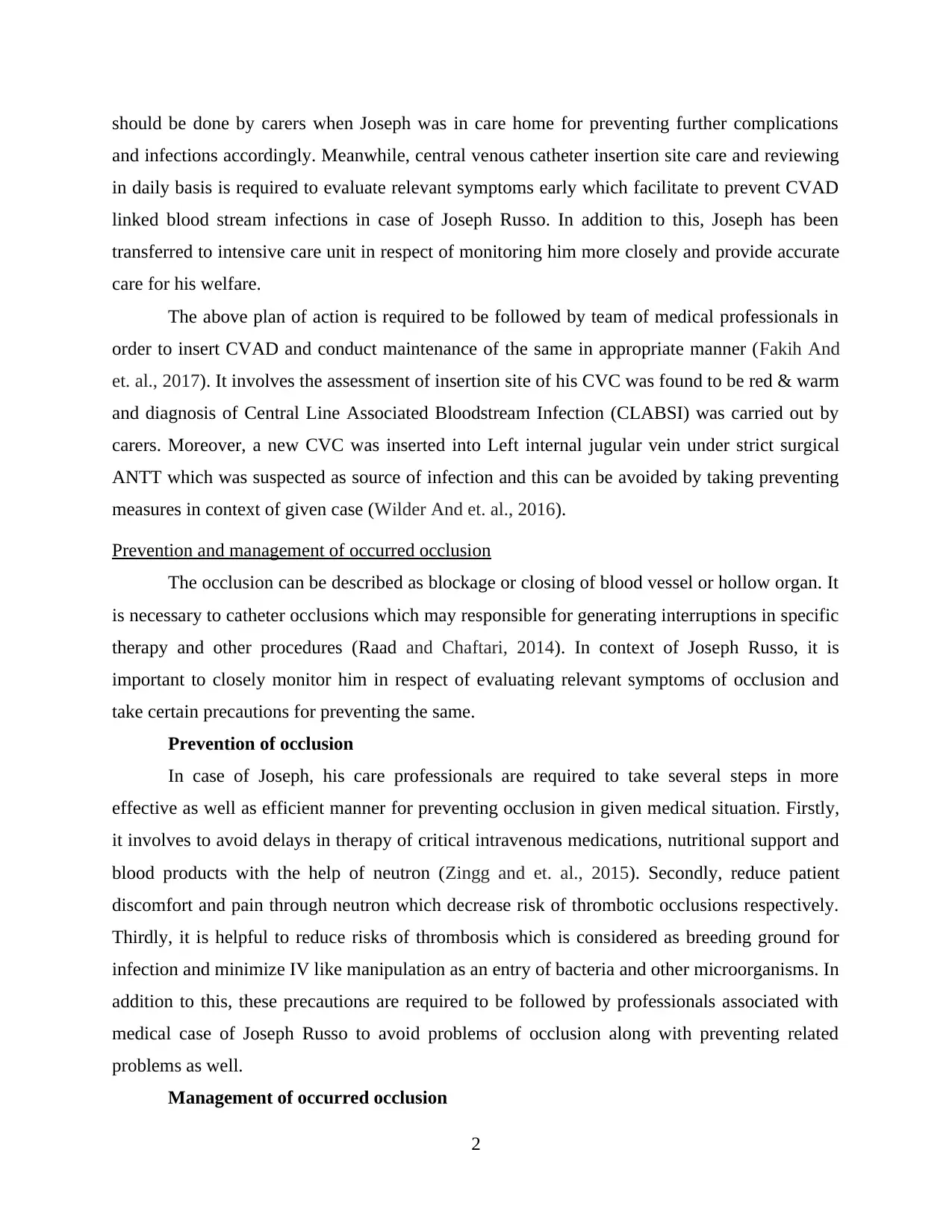
should be done by carers when Joseph was in care home for preventing further complications
and infections accordingly. Meanwhile, central venous catheter insertion site care and reviewing
in daily basis is required to evaluate relevant symptoms early which facilitate to prevent CVAD
linked blood stream infections in case of Joseph Russo. In addition to this, Joseph has been
transferred to intensive care unit in respect of monitoring him more closely and provide accurate
care for his welfare.
The above plan of action is required to be followed by team of medical professionals in
order to insert CVAD and conduct maintenance of the same in appropriate manner (Fakih And
et. al., 2017). It involves the assessment of insertion site of his CVC was found to be red & warm
and diagnosis of Central Line Associated Bloodstream Infection (CLABSI) was carried out by
carers. Moreover, a new CVC was inserted into Left internal jugular vein under strict surgical
ANTT which was suspected as source of infection and this can be avoided by taking preventing
measures in context of given case (Wilder And et. al., 2016).
Prevention and management of occurred occlusion
The occlusion can be described as blockage or closing of blood vessel or hollow organ. It
is necessary to catheter occlusions which may responsible for generating interruptions in specific
therapy and other procedures (Raad and Chaftari, 2014). In context of Joseph Russo, it is
important to closely monitor him in respect of evaluating relevant symptoms of occlusion and
take certain precautions for preventing the same.
Prevention of occlusion
In case of Joseph, his care professionals are required to take several steps in more
effective as well as efficient manner for preventing occlusion in given medical situation. Firstly,
it involves to avoid delays in therapy of critical intravenous medications, nutritional support and
blood products with the help of neutron (Zingg and et. al., 2015). Secondly, reduce patient
discomfort and pain through neutron which decrease risk of thrombotic occlusions respectively.
Thirdly, it is helpful to reduce risks of thrombosis which is considered as breeding ground for
infection and minimize IV like manipulation as an entry of bacteria and other microorganisms. In
addition to this, these precautions are required to be followed by professionals associated with
medical case of Joseph Russo to avoid problems of occlusion along with preventing related
problems as well.
Management of occurred occlusion
2
and infections accordingly. Meanwhile, central venous catheter insertion site care and reviewing
in daily basis is required to evaluate relevant symptoms early which facilitate to prevent CVAD
linked blood stream infections in case of Joseph Russo. In addition to this, Joseph has been
transferred to intensive care unit in respect of monitoring him more closely and provide accurate
care for his welfare.
The above plan of action is required to be followed by team of medical professionals in
order to insert CVAD and conduct maintenance of the same in appropriate manner (Fakih And
et. al., 2017). It involves the assessment of insertion site of his CVC was found to be red & warm
and diagnosis of Central Line Associated Bloodstream Infection (CLABSI) was carried out by
carers. Moreover, a new CVC was inserted into Left internal jugular vein under strict surgical
ANTT which was suspected as source of infection and this can be avoided by taking preventing
measures in context of given case (Wilder And et. al., 2016).
Prevention and management of occurred occlusion
The occlusion can be described as blockage or closing of blood vessel or hollow organ. It
is necessary to catheter occlusions which may responsible for generating interruptions in specific
therapy and other procedures (Raad and Chaftari, 2014). In context of Joseph Russo, it is
important to closely monitor him in respect of evaluating relevant symptoms of occlusion and
take certain precautions for preventing the same.
Prevention of occlusion
In case of Joseph, his care professionals are required to take several steps in more
effective as well as efficient manner for preventing occlusion in given medical situation. Firstly,
it involves to avoid delays in therapy of critical intravenous medications, nutritional support and
blood products with the help of neutron (Zingg and et. al., 2015). Secondly, reduce patient
discomfort and pain through neutron which decrease risk of thrombotic occlusions respectively.
Thirdly, it is helpful to reduce risks of thrombosis which is considered as breeding ground for
infection and minimize IV like manipulation as an entry of bacteria and other microorganisms. In
addition to this, these precautions are required to be followed by professionals associated with
medical case of Joseph Russo to avoid problems of occlusion along with preventing related
problems as well.
Management of occurred occlusion
2
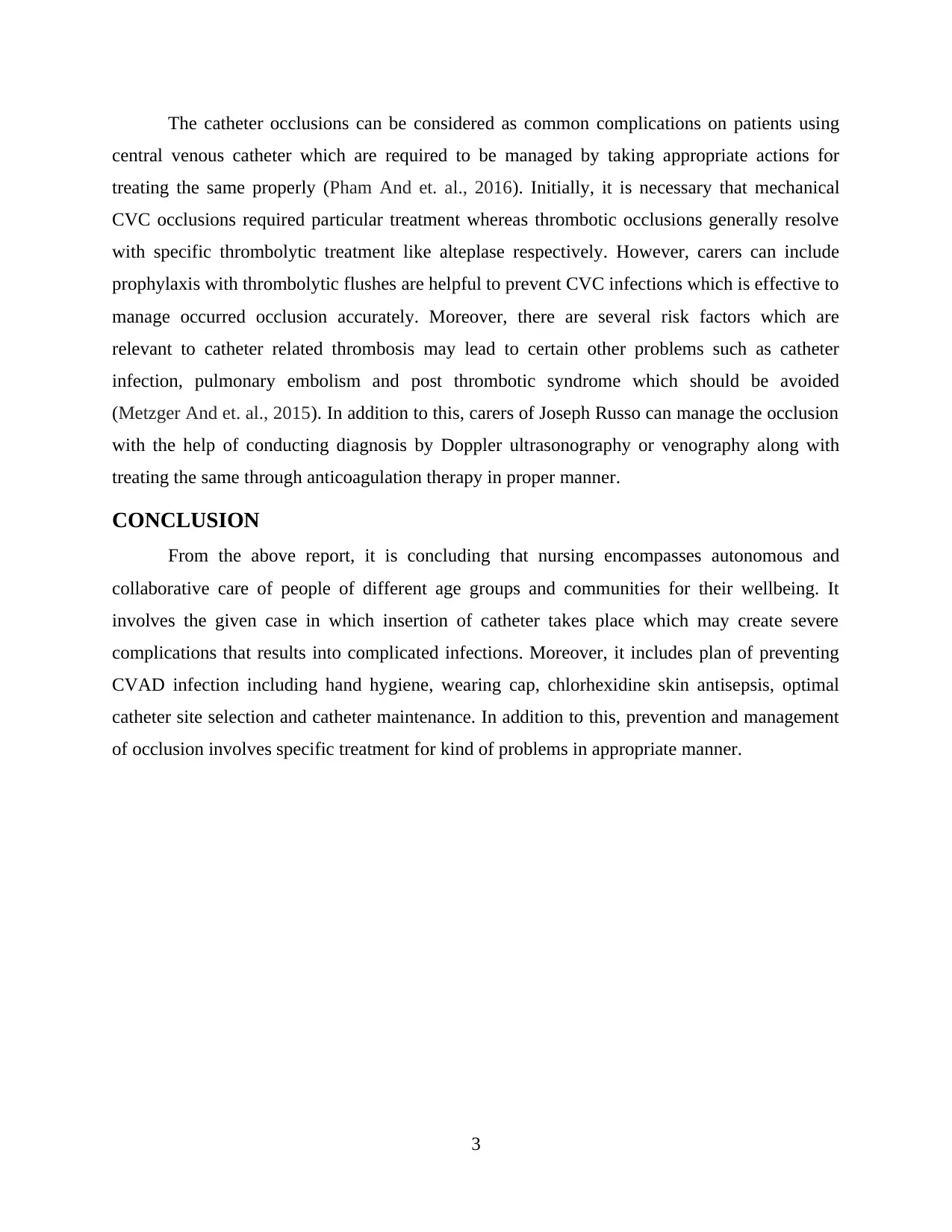
The catheter occlusions can be considered as common complications on patients using
central venous catheter which are required to be managed by taking appropriate actions for
treating the same properly (Pham And et. al., 2016). Initially, it is necessary that mechanical
CVC occlusions required particular treatment whereas thrombotic occlusions generally resolve
with specific thrombolytic treatment like alteplase respectively. However, carers can include
prophylaxis with thrombolytic flushes are helpful to prevent CVC infections which is effective to
manage occurred occlusion accurately. Moreover, there are several risk factors which are
relevant to catheter related thrombosis may lead to certain other problems such as catheter
infection, pulmonary embolism and post thrombotic syndrome which should be avoided
(Metzger And et. al., 2015). In addition to this, carers of Joseph Russo can manage the occlusion
with the help of conducting diagnosis by Doppler ultrasonography or venography along with
treating the same through anticoagulation therapy in proper manner.
CONCLUSION
From the above report, it is concluding that nursing encompasses autonomous and
collaborative care of people of different age groups and communities for their wellbeing. It
involves the given case in which insertion of catheter takes place which may create severe
complications that results into complicated infections. Moreover, it includes plan of preventing
CVAD infection including hand hygiene, wearing cap, chlorhexidine skin antisepsis, optimal
catheter site selection and catheter maintenance. In addition to this, prevention and management
of occlusion involves specific treatment for kind of problems in appropriate manner.
3
central venous catheter which are required to be managed by taking appropriate actions for
treating the same properly (Pham And et. al., 2016). Initially, it is necessary that mechanical
CVC occlusions required particular treatment whereas thrombotic occlusions generally resolve
with specific thrombolytic treatment like alteplase respectively. However, carers can include
prophylaxis with thrombolytic flushes are helpful to prevent CVC infections which is effective to
manage occurred occlusion accurately. Moreover, there are several risk factors which are
relevant to catheter related thrombosis may lead to certain other problems such as catheter
infection, pulmonary embolism and post thrombotic syndrome which should be avoided
(Metzger And et. al., 2015). In addition to this, carers of Joseph Russo can manage the occlusion
with the help of conducting diagnosis by Doppler ultrasonography or venography along with
treating the same through anticoagulation therapy in proper manner.
CONCLUSION
From the above report, it is concluding that nursing encompasses autonomous and
collaborative care of people of different age groups and communities for their wellbeing. It
involves the given case in which insertion of catheter takes place which may create severe
complications that results into complicated infections. Moreover, it includes plan of preventing
CVAD infection including hand hygiene, wearing cap, chlorhexidine skin antisepsis, optimal
catheter site selection and catheter maintenance. In addition to this, prevention and management
of occlusion involves specific treatment for kind of problems in appropriate manner.
3
⊘ This is a preview!⊘
Do you want full access?
Subscribe today to unlock all pages.

Trusted by 1+ million students worldwide
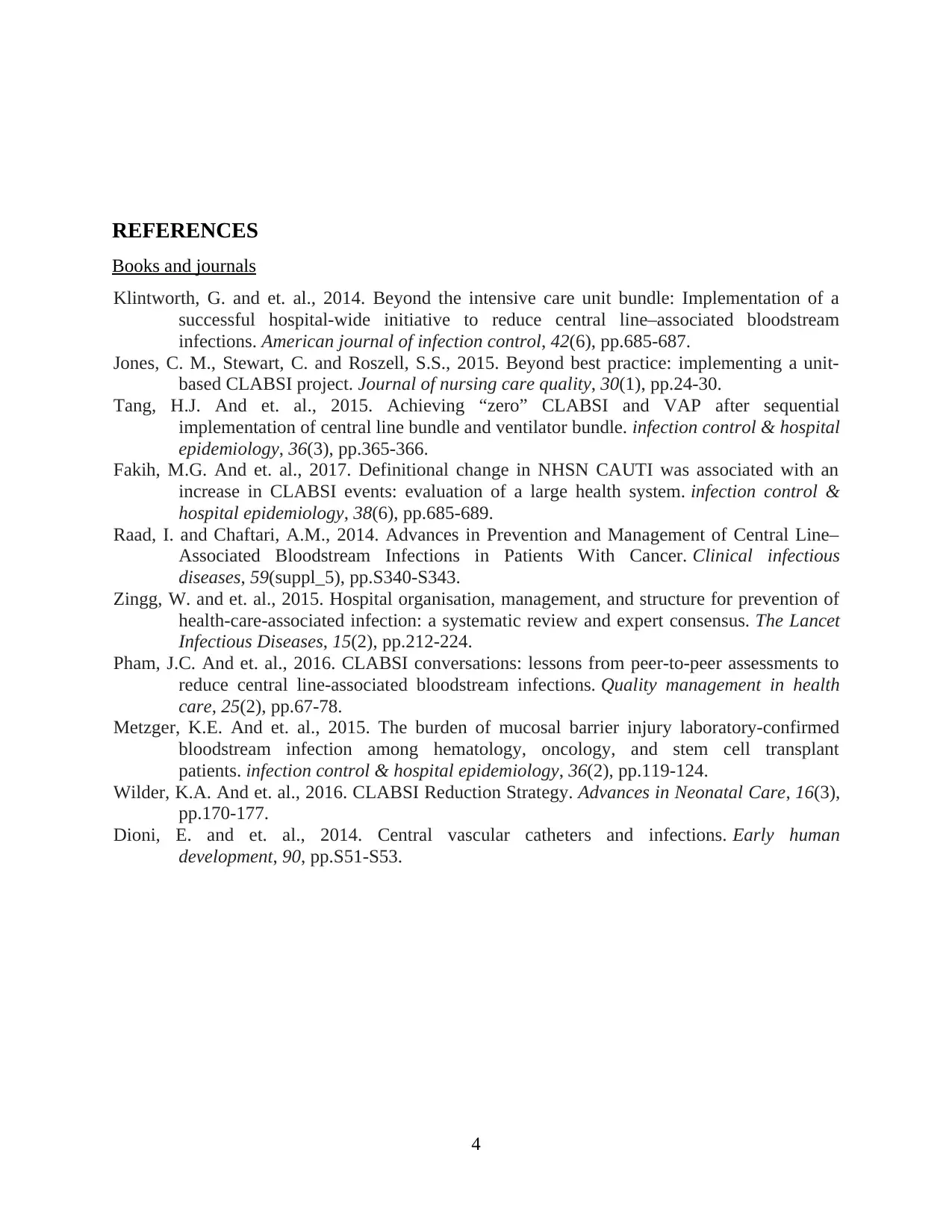
REFERENCES
Books and journals
Klintworth, G. and et. al., 2014. Beyond the intensive care unit bundle: Implementation of a
successful hospital-wide initiative to reduce central line–associated bloodstream
infections. American journal of infection control, 42(6), pp.685-687.
Jones, C. M., Stewart, C. and Roszell, S.S., 2015. Beyond best practice: implementing a unit-
based CLABSI project. Journal of nursing care quality, 30(1), pp.24-30.
Tang, H.J. And et. al., 2015. Achieving “zero” CLABSI and VAP after sequential
implementation of central line bundle and ventilator bundle. infection control & hospital
epidemiology, 36(3), pp.365-366.
Fakih, M.G. And et. al., 2017. Definitional change in NHSN CAUTI was associated with an
increase in CLABSI events: evaluation of a large health system. infection control &
hospital epidemiology, 38(6), pp.685-689.
Raad, I. and Chaftari, A.M., 2014. Advances in Prevention and Management of Central Line–
Associated Bloodstream Infections in Patients With Cancer. Clinical infectious
diseases, 59(suppl_5), pp.S340-S343.
Zingg, W. and et. al., 2015. Hospital organisation, management, and structure for prevention of
health-care-associated infection: a systematic review and expert consensus. The Lancet
Infectious Diseases, 15(2), pp.212-224.
Pham, J.C. And et. al., 2016. CLABSI conversations: lessons from peer-to-peer assessments to
reduce central line-associated bloodstream infections. Quality management in health
care, 25(2), pp.67-78.
Metzger, K.E. And et. al., 2015. The burden of mucosal barrier injury laboratory-confirmed
bloodstream infection among hematology, oncology, and stem cell transplant
patients. infection control & hospital epidemiology, 36(2), pp.119-124.
Wilder, K.A. And et. al., 2016. CLABSI Reduction Strategy. Advances in Neonatal Care, 16(3),
pp.170-177.
Dioni, E. and et. al., 2014. Central vascular catheters and infections. Early human
development, 90, pp.S51-S53.
4
Books and journals
Klintworth, G. and et. al., 2014. Beyond the intensive care unit bundle: Implementation of a
successful hospital-wide initiative to reduce central line–associated bloodstream
infections. American journal of infection control, 42(6), pp.685-687.
Jones, C. M., Stewart, C. and Roszell, S.S., 2015. Beyond best practice: implementing a unit-
based CLABSI project. Journal of nursing care quality, 30(1), pp.24-30.
Tang, H.J. And et. al., 2015. Achieving “zero” CLABSI and VAP after sequential
implementation of central line bundle and ventilator bundle. infection control & hospital
epidemiology, 36(3), pp.365-366.
Fakih, M.G. And et. al., 2017. Definitional change in NHSN CAUTI was associated with an
increase in CLABSI events: evaluation of a large health system. infection control &
hospital epidemiology, 38(6), pp.685-689.
Raad, I. and Chaftari, A.M., 2014. Advances in Prevention and Management of Central Line–
Associated Bloodstream Infections in Patients With Cancer. Clinical infectious
diseases, 59(suppl_5), pp.S340-S343.
Zingg, W. and et. al., 2015. Hospital organisation, management, and structure for prevention of
health-care-associated infection: a systematic review and expert consensus. The Lancet
Infectious Diseases, 15(2), pp.212-224.
Pham, J.C. And et. al., 2016. CLABSI conversations: lessons from peer-to-peer assessments to
reduce central line-associated bloodstream infections. Quality management in health
care, 25(2), pp.67-78.
Metzger, K.E. And et. al., 2015. The burden of mucosal barrier injury laboratory-confirmed
bloodstream infection among hematology, oncology, and stem cell transplant
patients. infection control & hospital epidemiology, 36(2), pp.119-124.
Wilder, K.A. And et. al., 2016. CLABSI Reduction Strategy. Advances in Neonatal Care, 16(3),
pp.170-177.
Dioni, E. and et. al., 2014. Central vascular catheters and infections. Early human
development, 90, pp.S51-S53.
4
1 out of 7
Related Documents
Your All-in-One AI-Powered Toolkit for Academic Success.
+13062052269
info@desklib.com
Available 24*7 on WhatsApp / Email
![[object Object]](/_next/static/media/star-bottom.7253800d.svg)
Unlock your academic potential
Copyright © 2020–2025 A2Z Services. All Rights Reserved. Developed and managed by ZUCOL.





